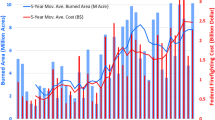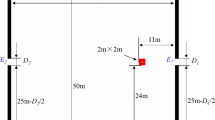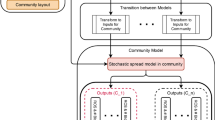Abstract
The current research on individual risks mainly focuses on the individual risk considering a single fire or the spatial distribution of multiple fires. It is more realistic to study spatial and temporal variations of individual risks. Based on the probit model, an improved approach is presented to assess the spatial and temporal variations of individual risks considering synergistic effects of multiple fires occurred sequentially. Firstly, the evolution sequence of multiple fires is estimated based on the probit model and the dynamic heat radiation distribution is calculated based on the Mudan model. Then, the critical heat radiation dose thresholds of different casualty levels are acquired based on literature data and the probit model which is applied to evaluate the relationship between heat radiation and the casualty level. Finally, the critical casualty time is proposed to reflect the temporal and spatial variations of individual risks. The dynamic individual risks of different escape strategies are assessed to assist in choosing the optimum escape plan. Furthermore, the critical safety escape distance is presented as a warning to provide a reference for the closest distance from firefighters to the center of the fire source. In the case study of multiple fires occurred sequentially in a storage tank farm, the critical casualty times of different casualty levels, the dynamic individual risk during the escape of a person, and the critical safe escape distance are estimated. Due to the low computational load, this approach can also assist in emergency decision-making at the fire accident site.












Similar content being viewed by others
References
Pasman HJ, Fouchier C, Park S et al (2020) Beirut ammonium nitrate explosion: Are not we really learning anything? Process Saf Prog 39(4):1–18. https://doi.org/10.1002/prs.12203
Chen Q, Wood M, Zhao J (2019) Case study of the Tianjin accident: application of barrier and systems analysis to understand challenges to industry loss prevention in emerging economies. Process Saf Environ Prot 131:178–188. https://doi.org/10.1016/j.psep.2019.08.028
Chen C, Reniers G, Khakzad N (2020) A thorough classification and discussion of approaches for modeling and managing domino effects in the process industries. Saf Sci 125:104618. https://doi.org/10.1016/j.ssci.2020.104618
Chen C, Reniers G, Zhang L (2018) An innovative methodology for quickly modeling the spatial-temporal evolution of domino accidents triggered by fire. J Loss Prev Process Ind 54:312–324. https://doi.org/10.1016/j.jlp.2018.04.012
Zhang L, Landucci G, Reniers G et al (2018) DAMS: a model to assess domino effects by using agent-based modeling and simulation. Risk Anal 38(8):1585–1600. https://doi.org/10.1111/risa.12955
Ding L, Khan FI, Abbassi R, Ji J (2019) FSEM: an approach to model contribution of synergistic effect of fires for domino effects. Reliab Eng Syst Saf 189:271–278. https://doi.org/10.1016/j.ress.2019.04.041
Ding L, Khan FI, Ji J (2020) A novel approach for domino effects modeling and risk analysis based on synergistic effect and accident evidence. Reliab Eng Syst Saf 203:107109. https://doi.org/10.1016/j.ress.2020.107109
Mohan AT, Coile RV, Hopkin D et al (2021) Risk tolerability limits for fire engineering design: methodology and reference case study. Fire Technol 57:2235–2267. https://doi.org/10.1007/s10694-021-01118-w
ISO (2012) ISO 16732‐1: 2012(E). Fire safety engineering—fire risk assessment—Part 1: general.
Uijt de Haag PAM, Ale BJM (1999) Guidelines for quantitative risk assessment (Purple Book). Committee for the Prevention of Disasters, The Hague
AIChE, CCPS (2000) Guidelines for chemical process quantitative risk analysis, 2nd edn. AIChE/CCPS, New York
Pula R, Khan FI, Veitch B, Amyotte PR (2005) Revised fire consequence models for offshore quantitative risk assessment. J Loss Prev Process Ind 18(4–6):443–454. https://doi.org/10.1016/j.jlp.2005.07.014
Yet-Pole I, Cheng T-L, Shu CM, Chong CH (2009) Applications of 3D QRA technique to the fire/explosion simulation and hazard mitigation within a naphtha-cracking plant. J Loss Prev Process Ind 22(4):506–515. https://doi.org/10.1016/j.jlp.2009.04.002
Cozzani V, Gubinelli G, Antonioni G et al (2005) The assessment of risk caused by domino effect in quantitative area risk analysis. J Hazard Mater 127(1–3):14–30. https://doi.org/10.1016/j.jhazmat.2005.07.003
Landucci G, Gubinelli G, Antonioni G, Cozzani V (2009) The assessment of the damage probability of storage tanks in domino events triggered by fire. Accid Anal Prev 41(6):1206–1215. https://doi.org/10.1016/j.aap.2008.05.006
Renjith VR, Madhu G (2010) Individual and societal risk analysis and mapping of human vulnerability to chemical accidents in the vicinity of an industrial area. Int J Appl Eng Res 1(2):135–148. https://doi.org/10.1016/j.cjche.2018.03.017
Abdolhamidzadeh B, Abbasi T, Rashtchian D, Abbasi SA (2010) A new method for assessing domino effect in chemical process industry. J Hazard Mater 182(1–3):416–426. https://doi.org/10.1016/j.jhazmat.2010.06.049
Liu AH, Wu C, Peng XQ (2012) Research on area risk assessment for chemical park based on domino effect model. Procedia Eng 45:47–52. https://doi.org/10.1016/j.proeng.2012.08.119
Zhao JL, Huang H, Li YT et al (2017) Quantitative risk assessment of continuous liquid spill fires based on spread and burning behaviours. Appl Therm Eng 126:500–506. https://doi.org/10.1016/j.cjche.2018.03.017
Johnson J (2014) Plant safety: ten years of negligence led to 2012 chevron refinery accident, report says. Chem Eng News 91(16):11. https://doi.org/10.1021/cen-09116-notw9
Van Den Bosh CJH (1989) Methods for the determination of possible damage (green book), CPR 16E. Committee for the Prevention of Disasters, The Hague
Mannan S (2012) Lees’ loss prevention in the process industries: hazard identification, assessment and control (3 volumes), 4th edn. Butterworth-Heinemann, Burlington
Khakzad N (2015) Application of dynamic Bayesian network to risk analysis of domino effects in chemical infrastructures. Reliab Eng Syst Saf 138:263–272. https://doi.org/10.1016/j.ress.2015.02.007
He ZC, Weng WG (2020) Synergic effects in the assessment of multi-hazard coupling disasters: fires, explosions, and toxicant leaks. J Hazard Mater 388:121813. https://doi.org/10.1016/j.jhazmat.2019.121813
Wan H, Yu L, Ji J (2021) Experimental study on mass burning rate and heat feedback mechanism of pair of unequal circular pool fires of heptane. Proc Combust Inst 38(3):4953–4961. https://doi.org/10.1016/j.proci.2020.07.079
Ge F, Simeoni A, Ji J, Wan H (2021) Experimental study on the evolution of heat feedback in multiple pool fires. Proc Combust Inst 38(3):4887–4895. https://doi.org/10.1016/j.proci.2020.06.050
Li B, Wan H, Ding L, Ji J (2021) Predicting radiative heat fluxes from two buoyant turbulent diffusion flames from burning propane under cross wind. Proc Combust Inst 38(3):4897–4906. https://doi.org/10.1016/j.proci.2020.07.019
Wieczorek CJ, Dembsey NA (2016) Effects of thermal radiation on people: predicting 1st and 2nd degree skin burns. In: Hurley MJ, Gottuk D, Hall JR et al (eds) SFPE handbook of fire protection engineering. Springer, New York, pp 2705–2737
Zhou K, Wang X (2019) Thermal radiation modelling of pool fire with consideration on the nonuniform temperature in flame volume. Int J Therm Sci 138:12–23. https://doi.org/10.1016/j.cjche.2018.03.017
Zhu Z, Quiel SE (2021) Near-field radiant heat flux from open-air gasoline and diesel pool fires: modified point source and discretized solid flame models. Fire Technol 57:1901–1926. https://doi.org/10.1007/s10694-021-01097-y
Mudan KS (1984) Thermal radiation hazards from hydrocarbon pool fires. Prog Energy Combust Sci 10(1):59–80. https://doi.org/10.1016/0360-1285(84)90119-9
Mudan KS (1987) Geometric view factors for thermal radiation hazard assessment. Fire Saf J 12(2):89–96. https://doi.org/10.1016/0379-7112(87)90024-5
van den Bosch CJH, Weterings RAPM (2005) Methods for the calculation of physical effects due to releases of hazardous materials (liquids and gases) (yellow book), 3rd edn. Publicatiereeks gevaarlijke stoffen, Hague
Finney DJ (1971) Probit analysis, 3rd edn. Cambridge University Press, London
Tsao C, Perry W (1979) Modifications to the vulnerability model: a simulation system for assessing damage resulting from marine spills (VM4). Defense Technical Information Center, Washington
LaChance J, Tchouvelev A, Engebo A (2011) Development of uniform harm criteria for use in quantitative risk analysis of the hydrogen infrastructure. Int J Hydrog Energy 36:2381–2388. https://doi.org/10.1016/j.ijhydene.2010.03.139
Mukhim ED, Abbasi T, Tauseef SM, Abbasi SA (2017) Domino effect in chemical process industries triggered by overpressure-formulation of equipment-specific probits. Process Saf Environ Prot 106:263–273. https://doi.org/10.1016/j.psep.2017.01.004
API (2014) API recommended practice 521: guide for pressure-relieving and depressuring systems. American Petroleum Institute, Washington, D.C.
Technica Ltd, Office of Environmental Affairs (1985) Manual of industrial hazard assessment techniques. Technica Ltd, Office of Environmental Affairs, Washington, D.C
Stoll AM, Greene LC (1959) Relationship between pain and tissue damage due to thermal radiation. J Appl Physiol 14(3):373–382. https://doi.org/10.1016/j.cjche.2018.03.017
Rodríguez-Garzón I, Martínez-Fiestas M, Delgado-Padial A, Lucas-Ruiz V (2016) Perception of occupational risk of firefighters in Quito (Ecuador). Fire Technol 52(3):753–773. https://doi.org/10.1007/s10694-015-0494-x
Bernechea EJ, Antonio Vilchez J, Arnaldos J (2013) A model for estimating the impact of the domino effect on accident frequencies in quantitative risk assessments of storage facilities. Process Saf Environ Prot 91(6):423–437. https://doi.org/10.1016/j.psep.2012.09.004
Kadri F, Chatelet E, Chen G (2013) Method for quantitative assessment of the domino effect in industrial sites. Process Saf Environ Prot 91(6):452–462. https://doi.org/10.1016/j.psep.2012.10.010
Khakzad N, Reniers G (2016) Application of Bayesian network and multi-criteria decision analysis to risk-based design of chemical plants. In: DeRademacher E, Schmelzer P (eds) 15th International symposium on loss prevention and safety promotion. pp 223–228.
Landucci G, Necci A, Antonioni G et al (2017) Risk assessment of mitigated domino scenarios in process facilities. Reliab Eng Syst Saf 160:37–53. https://doi.org/10.1016/j.ress.2016.11.023
Acknowledgements
This work was supported by the National Natural Science Foundation of China (NSFC) [Grant Number 51904284]; the Opening Project of Jiangsu Key Laboratory of Hazardous Chemicals Safety and Control [Grant Number HCSC201902]; and the Fundamental Research Funds for the Central Universities [Grant Number WK2320000050].
Author information
Authors and Affiliations
Contributions
JC: Methodology, Software, Writing—Original draft, Data curation. JJ: Conceptualization, Supervision, Project administration. XG: Visualization, Investigation. LD: Conceptualization, Writing—Review & Editing, Funding acquisition. All authors read and approved the final manuscript.
Corresponding author
Ethics declarations
Conflict of interest
The authors declared that there are no conflicts of interest.
Consent to participate
Not applicable.
Consent for publication
The authors consent for publication.
Ethical approval
All authors certify that they have no affiliations with or involvement in any organization or entity with any financial interest or non-financial interest in the subject matter or materials discussed in this manuscript.
Data availability
All the data used in this research will be made available upon request.
Code availability
All the code used in this research will be made available upon request.
Additional information
Publisher's Note
Springer Nature remains neutral with regard to jurisdictional claims in published maps and institutional affiliations.
Rights and permissions
About this article
Cite this article
Chen, J., Ji, J., Guo, X. et al. An Improved Approach for Spatial and Temporal Individual Risk Assessment Considering Synergistic Effects of Multiple Fires Occurred Sequentially. Fire Technol 58, 2093–2121 (2022). https://doi.org/10.1007/s10694-022-01236-z
Received:
Accepted:
Published:
Issue Date:
DOI: https://doi.org/10.1007/s10694-022-01236-z




